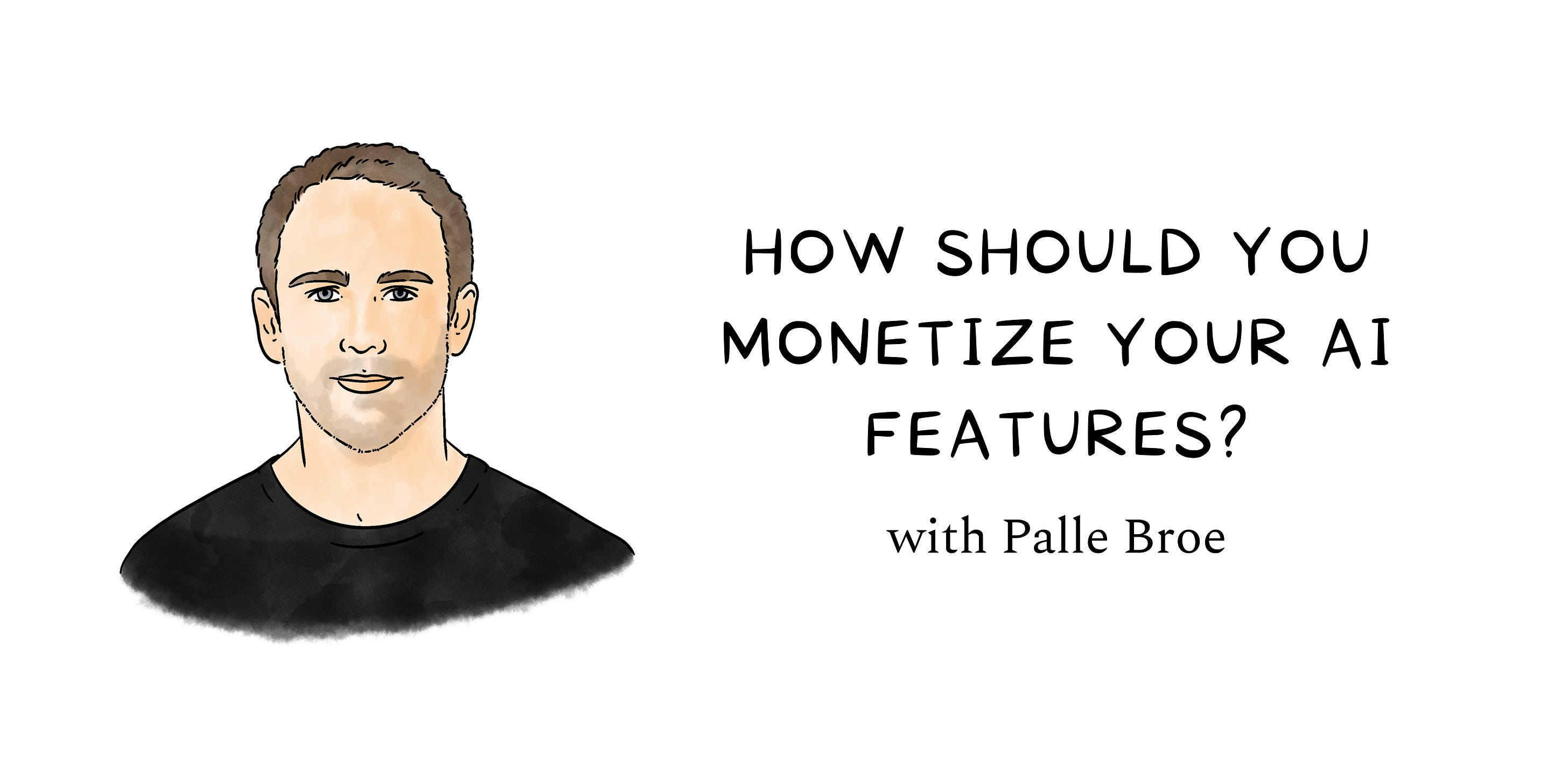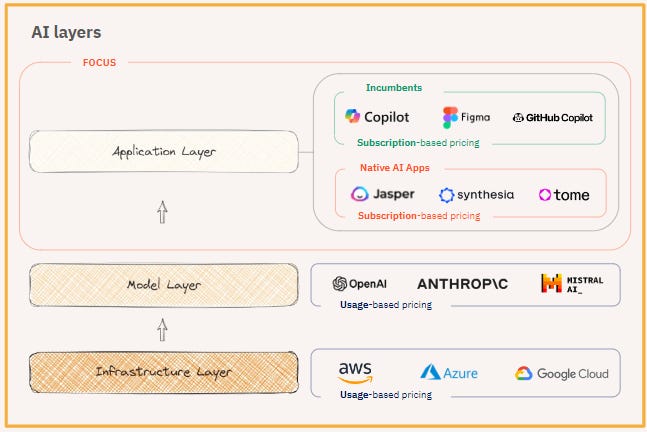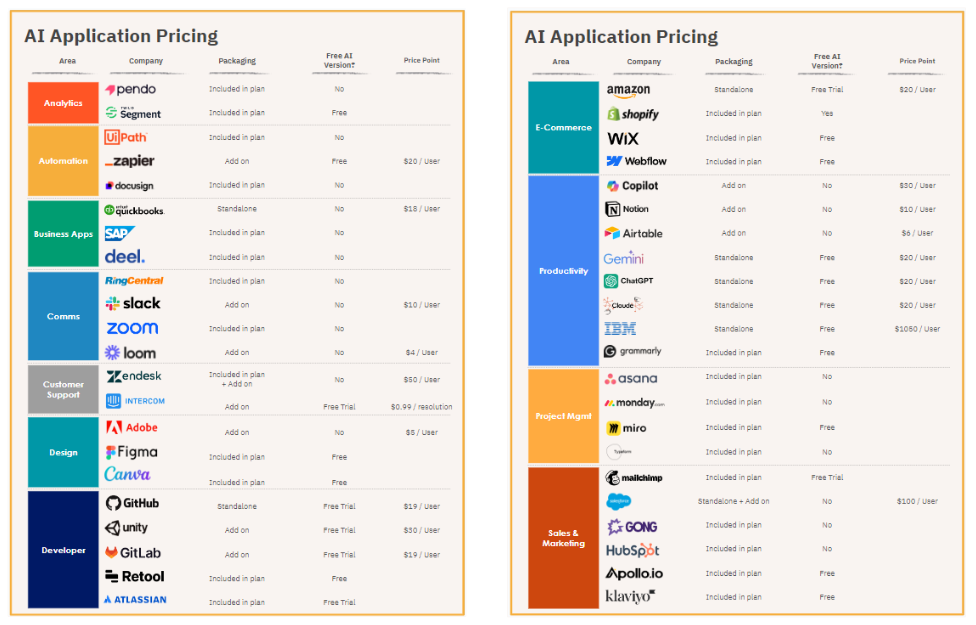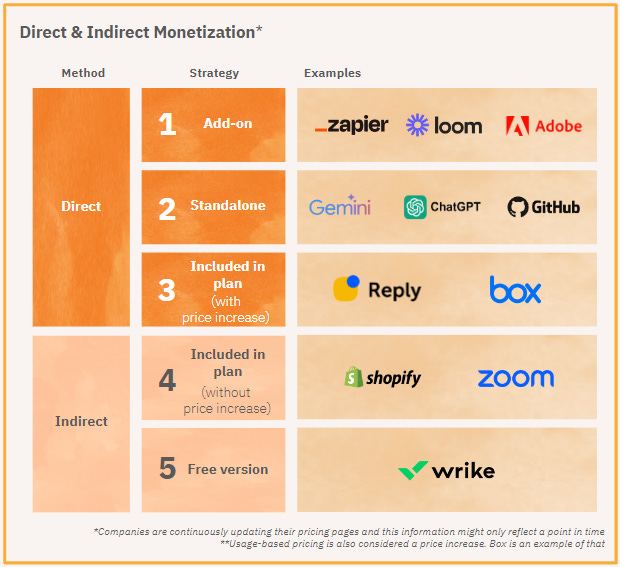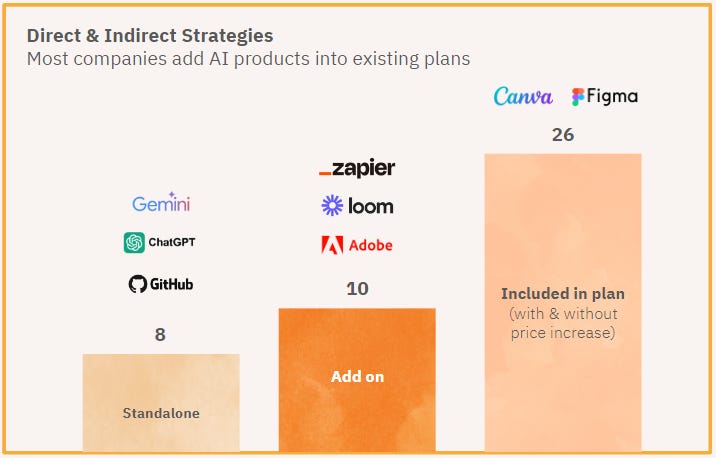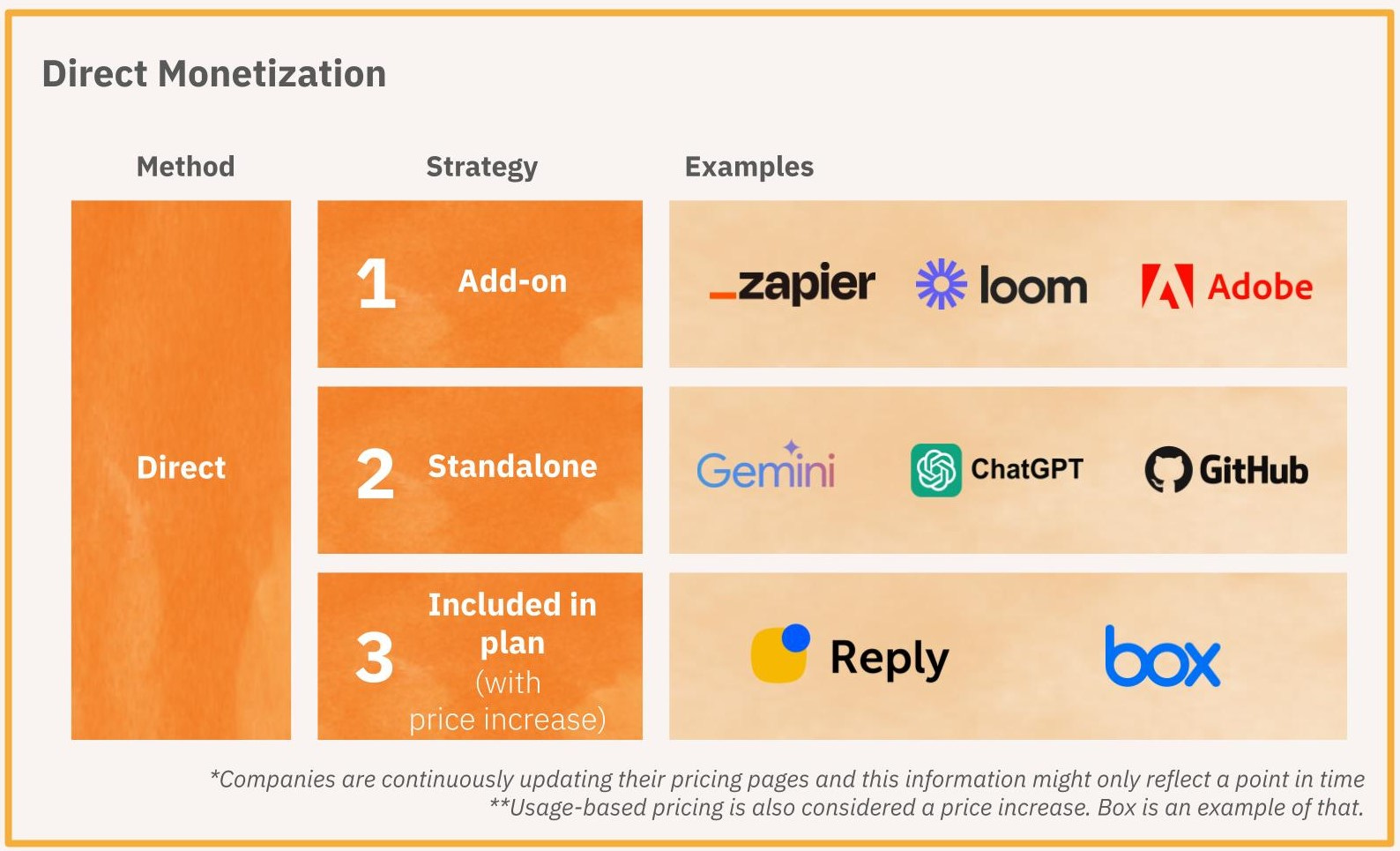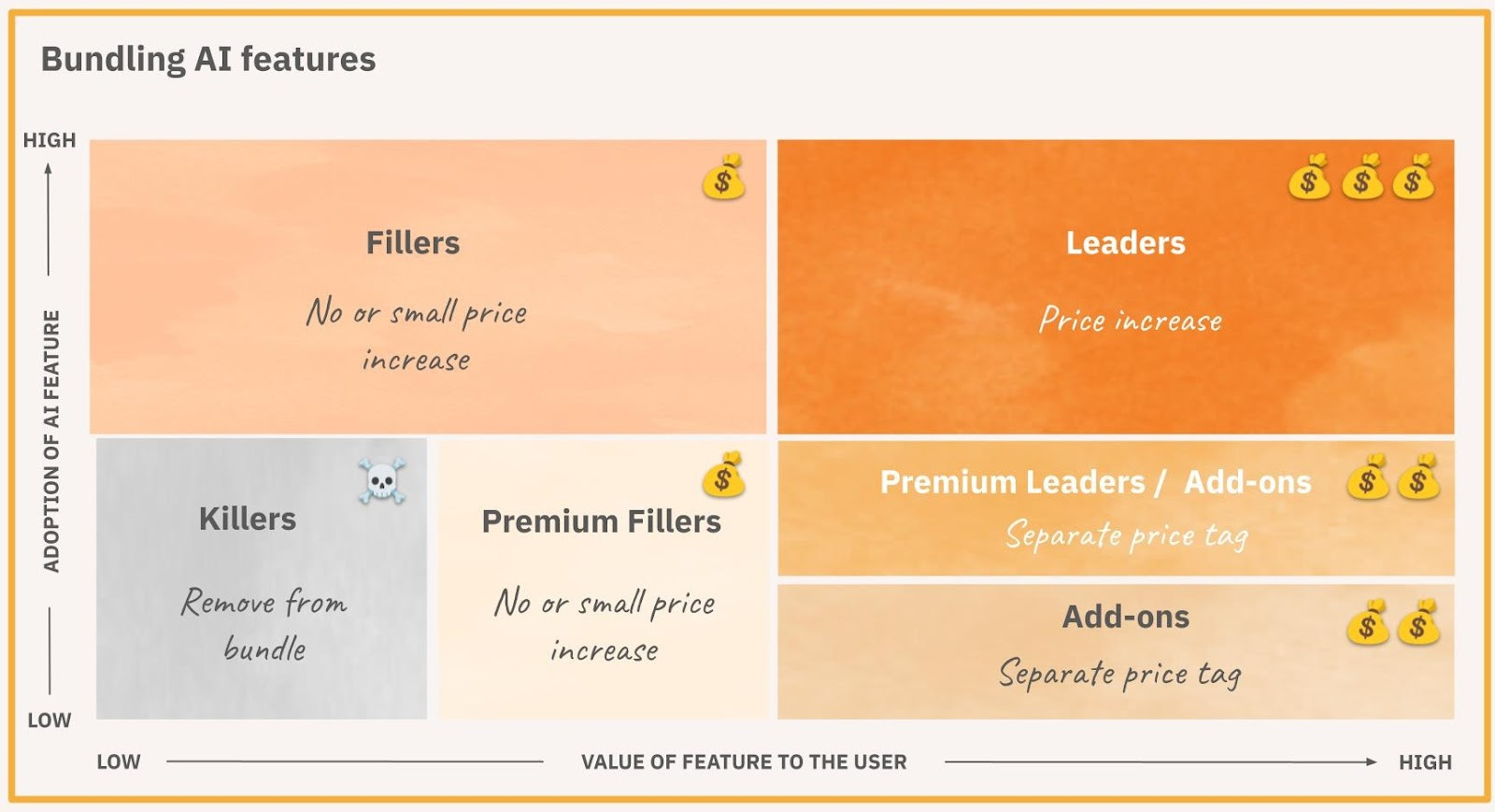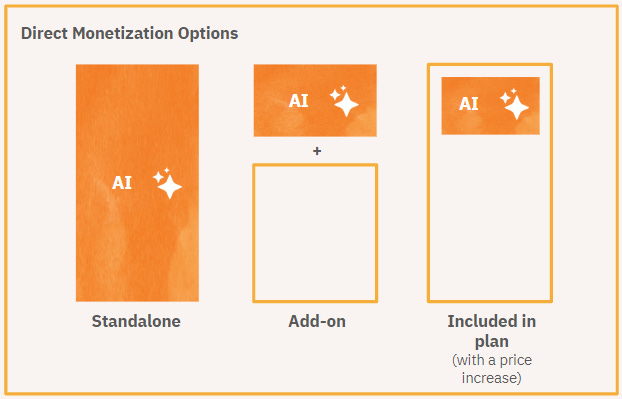How should you monetize your AI features?
How should you monetize your AI features?What we can learn from the monetization strategies of leading tech companies, including GitHub, Zapier, Adobe, Loom, and Microsoft👋 Hey, I’m Lenny and welcome to a 🔒 subscriber-only edition 🔒 of my weekly newsletter. Each week I tackle reader questions about building product, driving growth, and accelerating your career. For more: Best of Lenny’s Newsletter | Hire your next product leader | Podcast | Lennybot | Swag
Pricing and AI: individually, two of the most mysterious topics for product builders. Put them together, and things get dizzying. To answer your questions in the most comprehensive way possible, I teamed up with Palle Broe to analyze how leading tech companies are approaching AI pricing and, from that, create a framework to help you make decisions about how to price your own AI products and features. Palle Broe was part of the early team building Uber in San Francisco and the U.K. and then spent five years across various operational, strategy, and product roles at the company. He led pricing strategy while at Uber (B2C) and then at Templafy (B2B SaaS), and has advised more than 20 fast-growing tech startups (seed to Series D) on monetization strategy, creating better packaging, cutting back on discounts, and building stronger ROI and business cases. I’m excited to offer you his insights on pricing for AI features and products, which looks very different than it does for other technologies. For more from Palle, make sure to subscribe to his newsletter, Rule of Thumb, where he provides tangible pricing advice to operators, and follow him on LinkedIn. AI features and products present brand-new pricing challenges for companies. I’ve spent the past decade working on monetization strategies for places like Uber and Templafy, as well as advising more than 20 tech companies on their approaches, and what I’m seeing around AI products is very different from older technologies. Unlike with traditional SaaS products, companies looking to integrate AI products and features need to consider the real, underlying costs of generative AI compute and the intense competitive pressure in the AI market now, while also focusing on adoption and new business models. To ensure long-term ROI, companies have always needed to think carefully about how and when to monetize, but AI requires even deeper analysis. During Alphabet’s 2024 Q2 earnings call, many questions from investors addressed the ROI of the company’s $12 billion AI investments—a real shift from the previous quarter’s call. It’s clear that investor focus is changing from pure adoption to how big tech is going to be monetizing their innovations. This left me wondering: How do tech companies monetize their new AI features today? And what can we learn from that data? To answer, I investigated the pricing and bundling strategies of 44 leading tech incumbents. I focused on the “application layer”—companies that are building end-user products (e.g. Figma)—rather than base models (OpenAI’s LLM) or infrastructure (e.g. Azure). We reviewed public data for pricing models, value metrics, bundling, and free versions to identify current trends. Based on that data and my own experience in pricing, I’ve put together a framework for you to help make strategic decisions for your own AI products and features.
1. Direct and indirect monetization strategiesBroadly speaking, there are two methods that companies can use to monetize AI features: direct and indirect monetization. Direct monetization involves charging for the AI feature directly, or increasing the price of your product after adding the new AI feature. Conversely, indirect monetization integrates the AI feature into an existing bundle without altering the price, or offers the feature on its own at no additional cost. Below is an overview of the five high-level monetization strategies we are seeing right now for tech companies launching AI features and products. What companies are doing nowThe predominant strategy we saw in the data was to bundle the AI features into existing packages (59% of companies chose this path). This approach allows users with current subscriptions to benefit from AI capabilities. In some instances, this integration is accompanied by a price increase or usage-based pricing for the AI feature—making it a direct strategy. In others, it is added without altering the existing pricing structure—an indirect approach. Adding AI features to an existing bundle can be used as an interim strategy to launch quickly and before thinking more carefully about monetization as more data is gathered around usage of the AI feature. The second most common approach is a direct strategy: offering AI features as an add-on with a distinct price tag (23% of companies chose this path). The add-on strategy is the “purest” form of direct monetization and will provide you with the cleanest data in terms of adoption and monetization. Also, the ability to track the direct impact of your AI feature will enable you to understand willingness to pay and can provide important feedback to the roadmap and product development. Additionally, some companies (18% of those reviewed), particularly those with large language models (LLMs), have developed standalone AI products available for separate purchase, independent of any existing subscriptions. How you can choose between direct and indirect monetizationThere’s a reason the majority of the companies we looked at used a direct monetization strategy. As a rule of thumb, I believe direct is best, either offering the new AI feature/product as an add-on or bundling it in the existing plan with a price increase (or usage-based component). And this seems to be the path many of the largest tech companies took. It’s critical to understand willingness to pay and the underlying cost structures associated with gen AI, and employing this strategy will enable you to understand both. One of the core issues in applying indirect monetization is that it can be very hard to track and accurately attribute the value from increased retention and upsell. Direct monetization is likely the right choice if your company has:
An indirect monetization strategy (e.g. including it in a plan without a price increase, or giving it away for free) can be successful when generative AI features significantly boost usage, conversion, or retention of your core product. This results in indirect revenue gains that outweigh the costs for these features—particularly when you have usage-based pricing or when the AI feature greatly increases overall customer conversion or retention. Zoom and Shopify are two examples of companies that have pursued this strategy. Sometimes this is an interim strategy to get user feedback before integrating a price increase once the value to the user is better understood. Making price increases with a large customer base is not an easy task and needs to be handled extremely thoughtfully. In my experience—and in the data—indirect monetization is usually the less attractive choice, particularly long-term. In reality, very few companies get to choose their monetization strategy in isolation. If a competing company is launching a similar AI feature but choosing an indirect monetization strategy, you will have to take that into account alongside all the other variables above. It might be the right decision to follow suit to ensure competitiveness, but ultimately this will depend on multiple factors not discussed in detail in this article. 2. Direct monetization deep diveNext, let’s dig deeper into the three core strategies for direct monetization (add-on, standalone, and included in plan with a price increase) and break down which path might be the best for your company. Typically, the factors to consider are the value your AI feature delivers for the user and your business, the best bundling approach, and the optimal distribution of the AI features across different package tiers. Step 1: Defining the role AI will play in your product portfolioConsider the following questions:
Once you’ve gotten answers to the above, you can place the feature on the map below to identify the best path for bundling your AI feature. As an example, if your AI feature is one that is widely used by users (more than 70%) and adds a lot of value to their work, it’s a “leader” feature in your bundle and could likely result in a price increase. On the other hand, if your AI feature is used by relatively few users in a company (say, 20%) but those users love the feature, it should be an “add-on” to your bundle: Step 2: Evaluate the three direct strategy optionsSubscribe to Lenny's Newsletter to unlock the rest.Become a paying subscriber of Lenny's Newsletter to get access to this post and other subscriber-only content. A subscription gets you:
|
Older messages
Announcing the Lenny & Friends Summit 🙌
Monday, July 29, 2024
A one-day in-person event for senior product leaders ͏ ͏ ͏ ͏ ͏ ͏ ͏ ͏ ͏ ͏ ͏ ͏ ͏ ͏ ͏ ͏ ͏ ͏ ͏ ͏ ͏ ͏ ͏ ͏ ͏ ͏ ͏ ͏ ͏ ͏ ͏ ͏ ͏ ͏ ͏ ͏ ͏ ͏ ͏ ͏ ͏ ͏ ͏ ͏ ͏ ͏ ͏ ͏ ͏ ͏ ͏ ͏ ͏ ͏ ͏ ͏ ͏ ͏ ͏ ͏ ͏ ͏ ͏ ͏ ͏ ͏ ͏ ͏ ͏ ͏ ͏ ͏ ͏ ͏
The ultimate guide to performance marketing | Timothy Davis (Shopify)
Sunday, July 28, 2024
Discover performance marketing tips from Timothy Davis, covering team building, paid ads, AI trends, and more from his experience at Shopify and beyond. ͏ ͏ ͏ ͏ ͏ ͏ ͏ ͏ ͏ ͏ ͏ ͏ ͏ ͏ ͏ ͏ ͏ ͏ ͏ ͏ ͏ ͏ ͏ ͏
5 essential questions to craft a winning strategy | Roger Martin (author, advisor, speaker)
Thursday, July 25, 2024
Dive into Roger Martin's strategy wisdom with real-world examples from P&G, Lego, and more. Learn how to play to win. ͏ ͏ ͏ ͏ ͏ ͏ ͏ ͏ ͏ ͏ ͏ ͏ ͏ ͏ ͏ ͏ ͏ ͏ ͏ ͏ ͏ ͏ ͏ ͏ ͏ ͏ ͏ ͏ ͏ ͏ ͏ ͏ ͏ ͏ ͏ ͏ ͏ ͏
New data on the product job market
Tuesday, July 23, 2024
5 surprising trends about who's hiring, what roles are growing fastest, and the one role that's disappearing ͏ ͏ ͏ ͏ ͏ ͏ ͏ ͏ ͏ ͏ ͏ ͏ ͏ ͏ ͏ ͏ ͏ ͏ ͏ ͏ ͏ ͏ ͏ ͏ ͏ ͏ ͏ ͏ ͏ ͏ ͏ ͏ ͏ ͏ ͏ ͏ ͏ ͏ ͏ ͏ ͏ ͏
What most people miss about marketing | Rory Sutherland (Vice Chairman of Ogilvy UK, author)
Sunday, July 21, 2024
Discover Rory Sutherland's insights on why good products fail, the power of fame, and "thinking psycho-logically" in marketing. ͏ ͏ ͏ ͏ ͏ ͏ ͏ ͏ ͏ ͏ ͏ ͏ ͏ ͏ ͏ ͏ ͏ ͏ ͏ ͏ ͏ ͏ ͏ ͏ ͏ ͏ ͏ ͏ ͏ ͏
You Might Also Like
🚀 Ready to scale? Apply now for the TinySeed SaaS Accelerator
Friday, February 14, 2025
What could $120K+ in funding do for your business?
📂 How to find a technical cofounder
Friday, February 14, 2025
If you're a marketer looking to become a founder, this newsletter is for you. Starting a startup alone is hard. Very hard. Even as someone who learned to code, I still believe that the
AI Impact Curves
Friday, February 14, 2025
Tomasz Tunguz Venture Capitalist If you were forwarded this newsletter, and you'd like to receive it in the future, subscribe here. AI Impact Curves What is the impact of AI across different
15 Silicon Valley Startups Raised $302 Million - Week of February 10, 2025
Friday, February 14, 2025
💕 AI's Power Couple 💰 How Stablecoins Could Drive the Dollar 🚚 USPS Halts China Inbound Packages for 12 Hours 💲 No One Knows How to Price AI Tools 💰 Blackrock & G42 on Financing AI
The Rewrite and Hybrid Favoritism 🤫
Friday, February 14, 2025
Dogs, Yay. Humans, Nay͏ ͏ ͏ ͏ ͏ ͏ ͏ ͏ ͏ ͏ ͏ ͏ ͏ ͏ ͏ ͏ ͏ ͏ ͏ ͏ ͏ ͏ ͏ ͏ ͏ ͏ ͏ ͏ ͏ ͏ ͏ ͏ ͏ ͏ ͏ ͏ ͏ ͏ ͏ ͏ ͏ ͏ ͏ ͏ ͏ ͏ ͏ ͏ ͏ ͏ ͏ ͏ ͏ ͏ ͏ ͏ ͏ ͏ ͏ ͏
🦄 AI product creation marketplace
Friday, February 14, 2025
Arcade is an AI-powered platform and marketplace that lets you design and create custom products, like jewelry.
Crazy week
Friday, February 14, 2025
Crazy week. ͏ ͏ ͏ ͏ ͏ ͏ ͏ ͏ ͏ ͏ ͏ ͏ ͏ ͏ ͏ ͏ ͏ ͏ ͏ ͏ ͏ ͏ ͏ ͏ ͏ ͏ ͏ ͏ ͏ ͏ ͏ ͏ ͏ ͏ ͏ ͏ ͏ ͏ ͏ ͏ ͏ ͏ ͏ ͏ ͏ ͏ ͏ ͏ ͏ ͏ ͏ ͏ ͏ ͏ ͏ ͏ ͏ ͏ ͏ ͏ ͏ ͏ ͏ ͏ ͏ ͏ ͏ ͏ ͏ ͏ ͏ ͏ ͏ ͏ ͏ ͏ ͏ ͏ ͏ ͏ ͏ ͏ ͏ ͏ ͏ ͏ ͏ ͏ ͏ ͏ ͏ ͏ ͏ ͏ ͏
join me: 6 trends shaping the AI landscape in 2025
Friday, February 14, 2025
this is tomorrow Hi there, Isabelle here, Senior Editor & Analyst at CB Insights. Tomorrow, I'll be breaking down the biggest shifts in AI – from the M&A surge to the deals fueling the
Six Startups to Watch
Friday, February 14, 2025
AI wrappers, DNA sequencing, fintech super-apps, and more. ͏ ͏ ͏ ͏ ͏ ͏ ͏ ͏ ͏ ͏ ͏ ͏ ͏ ͏ ͏ ͏ ͏ ͏ ͏ ͏ ͏ ͏ ͏ ͏ ͏ ͏ ͏ ͏ ͏ ͏ ͏ ͏ ͏ ͏ ͏ ͏ ͏ ͏ ͏ ͏ ͏ ͏ ͏ ͏ ͏ ͏ ͏ ͏ ͏ ͏ ͏ ͏ ͏ ͏ ͏ ͏ ͏ ͏ ͏ ͏ ͏ ͏ ͏ ͏ ͏ ͏ ͏ ͏ ͏ ͏ ͏
How Will AI-Native Games Work? Well, Now We Know.
Friday, February 14, 2025
A Deep Dive Into Simcluster ͏ ͏ ͏ ͏ ͏ ͏ ͏ ͏ ͏ ͏ ͏ ͏ ͏ ͏ ͏ ͏ ͏ ͏ ͏ ͏ ͏ ͏ ͏ ͏ ͏ ͏ ͏ ͏ ͏ ͏ ͏ ͏ ͏ ͏ ͏ ͏ ͏ ͏ ͏ ͏ ͏ ͏ ͏ ͏ ͏ ͏ ͏ ͏ ͏ ͏ ͏ ͏ ͏ ͏ ͏ ͏ ͏ ͏ ͏ ͏ ͏ ͏ ͏ ͏ ͏ ͏ ͏ ͏ ͏ ͏ ͏ ͏ ͏ ͏ ͏ ͏ ͏ ͏ ͏ ͏ ͏ ͏ ͏ ͏ ͏ ͏ ͏

